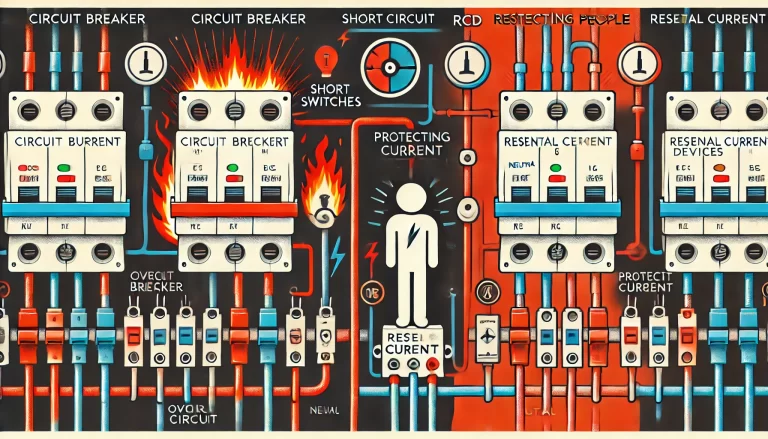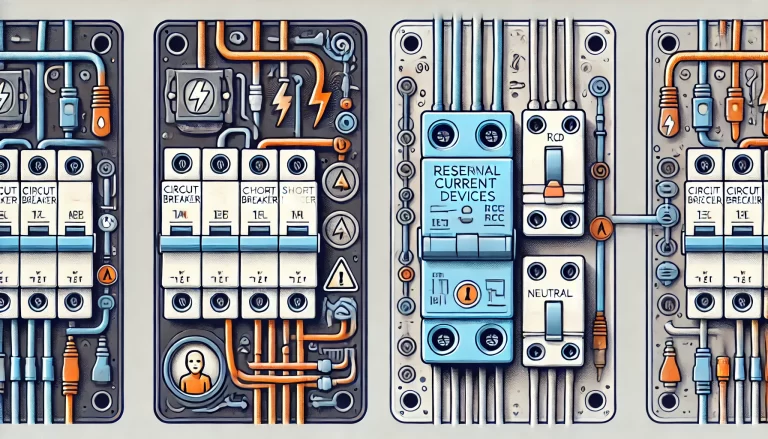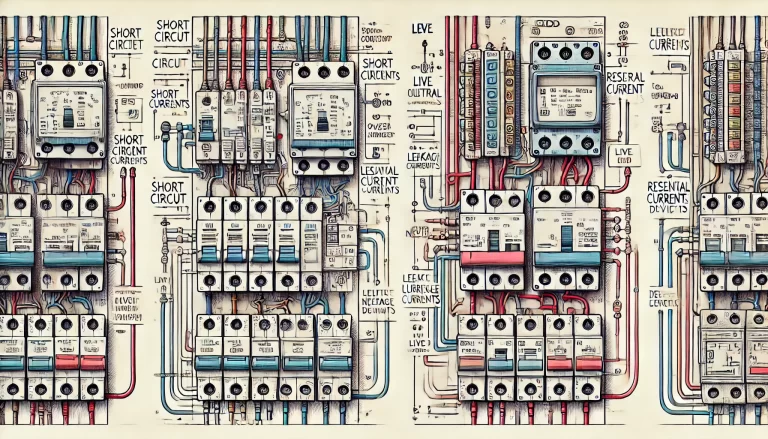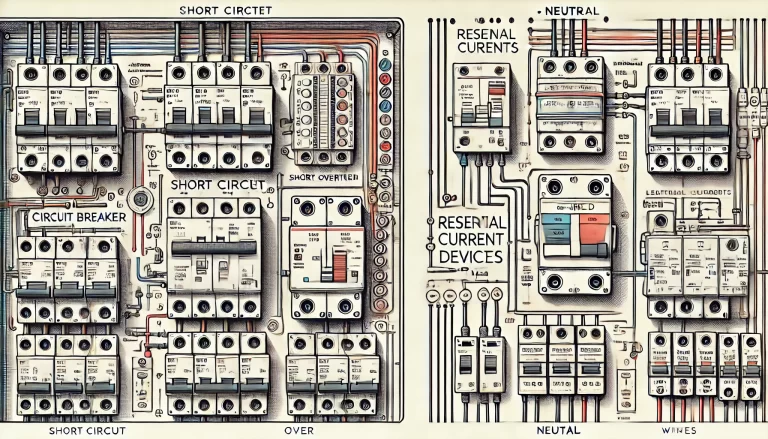In modern electrical systems, circuit breakers (commonly known as air switches) and Residual Current Devices (RCDs), also referred to as leakage protectors, are two essential safety components. Although they both serve to protect electrical systems and users, their functions, mechanisms, and applications differ significantly. Below is a more detailed exploration of the differences between circuit breakers and RCDs, emphasizing how they operate and their respective roles in electrical safety.
1. Function
Circuit Breakers (Air Switches): Circuit breakers are designed primarily for overload and short circuit protection. Their job is to interrupt the flow of electricity if the current exceeds a certain threshold, which could happen due to a malfunction or when too many devices are connected to the circuit, leading to excessive power draw. They ensure that electrical systems are not damaged by these conditions and help prevent fire hazards caused by overheated wiring.
Residual Current Devices (RCDs): RCDs are designed specifically to protect against leakage currents. Their primary function is to detect any imbalance in the electrical current between the live (hot) wire and the neutral wire, which could indicate a leakage of current, potentially due to a fault or contact with a person. If such a leakage occurs, the RCD immediately cuts off the power to prevent electric shock and safeguard human life. This makes them a crucial component in environments where accidental contact with electrical components is possible, such as in wet areas.

2. Types of Protection
Circuit Breakers: Circuit breakers protect the electrical equipment and wiring in a circuit. They ensure that electrical systems don’t experience overcurrent or short circuits, which could cause damage to devices, fires, or other hazards. Circuit breakers are triggered by thermal or electromagnetic mechanisms when current levels exceed safe limits.
RCDs: RCDs primarily protect people from electrical shocks by detecting leakage currents, which are currents that stray from the intended path and could flow through a person to the ground. This can happen when insulation is faulty or when water makes accidental contact with live electrical components. RCDs trip the circuit if even a small amount of leakage current (typically 30 milliamps or more) is detected, acting as a safeguard for human life.
3. Working Principle
Circuit Breakers: Circuit breakers work based on two main mechanisms:
- Thermal Overload Protection: When too much current flows through the breaker, a bimetallic strip inside the device heats up and bends, eventually triggering the circuit breaker to open and stop the flow of electricity.
- Magnetic Short Circuit Protection: In the case of a short circuit, the rapid surge of current creates a strong magnetic field that activates a solenoid or electromagnet, which forces the breaker to open the circuit almost instantly.
RCDs: RCDs, on the other hand, operate by monitoring the electrical current flowing through the live and neutral wires. In a balanced circuit, the current flowing into the system through the live wire should equal the current returning via the neutral wire. However, if some current escapes due to a fault, causing an imbalance (for instance, through a human body to the ground), the RCD detects this difference and disconnects the power within milliseconds.

4. Reaction Time
Circuit Breakers: The reaction time of a circuit breaker depends on the level of current passing through it. For small overcurrent situations (such as a slow overload), the breaker may take seconds or even minutes to trip. In the case of a short circuit, where a large surge of current occurs, the breaker can trip almost instantaneously (within a fraction of a second).
RCDs: RCDs are designed to react very quickly to even small differences in current, typically cutting off power within 25-40 milliseconds. This rapid response is critical in preventing dangerous electric shocks that could otherwise prove fatal if the current flows through a human body.
5. Installation and Positioning
Circuit Breakers: Circuit breakers are generally installed in the main distribution panel (also known as the breaker box) of a building. They serve as the first line of defense against electrical hazards like overcurrent and short circuits. Multiple circuit breakers are often used to protect individual circuits in a home or industrial setup.
RCDs: RCDs are also often installed in the distribution panel but may be used alongside circuit breakers or even integrated into them in combined devices known as RCBOs (Residual Current Breaker with Overcurrent protection). Additionally, RCDs may be installed on specific circuits that pose a higher risk of electrical leakage, such as those supplying bathrooms, kitchens, or outdoor power outlets.

6. Application Scenarios
Circuit Breakers: Circuit breakers are versatile and are installed in almost all electrical systems to protect wiring and electrical devices. They are used in both residential and industrial environments. From simple household lighting circuits to complex industrial machinery, circuit breakers are essential for overcurrent protection.
RCDs: RCDs are particularly important in environments where human safety is the priority. These include areas with higher risks of electrical shock due to moisture, such as bathrooms, kitchens, and outdoor outlets. In many countries, RCD installation is mandatory in circuits that supply power to outlets in wet areas or in areas where power tools and equipment are used (e.g., garages and workshops).
7. Limitations
Circuit Breakers: Circuit breakers do not protect against electrical leakage. They will not trip if a person accidentally touches a live wire and is subject to an electric shock, as long as the current drawn does not exceed the breaker’s rating. Their sole purpose is to protect the circuit and devices, not to prevent electric shocks.
RCDs: RCDs are not designed to protect against overload or short circuits. While they offer excellent protection against electrical leaks and shocks, they must be used in conjunction with circuit breakers to ensure complete protection of an electrical system. A combined device, such as an RCBO, provides both overcurrent and leakage protection.

Conclusion
In summary, while both circuit breakers and RCDs are vital for electrical safety, their roles differ significantly. Circuit breakers focus on protecting electrical equipment and wiring from damage due to overloads or short circuits, ensuring the longevity and safety of the system. RCDs, on the other hand, are life-saving devices that protect people from electric shock by detecting leakage currents and cutting off power almost instantly.
To ensure a fully protected electrical system, both devices are often used together. The circuit breaker shields the electrical infrastructure, while the RCD provides an essential layer of protection for human safety. When designing or maintaining an electrical installation, understanding the distinct functions of these devices helps ensure a safer environment for both people and equipment.
